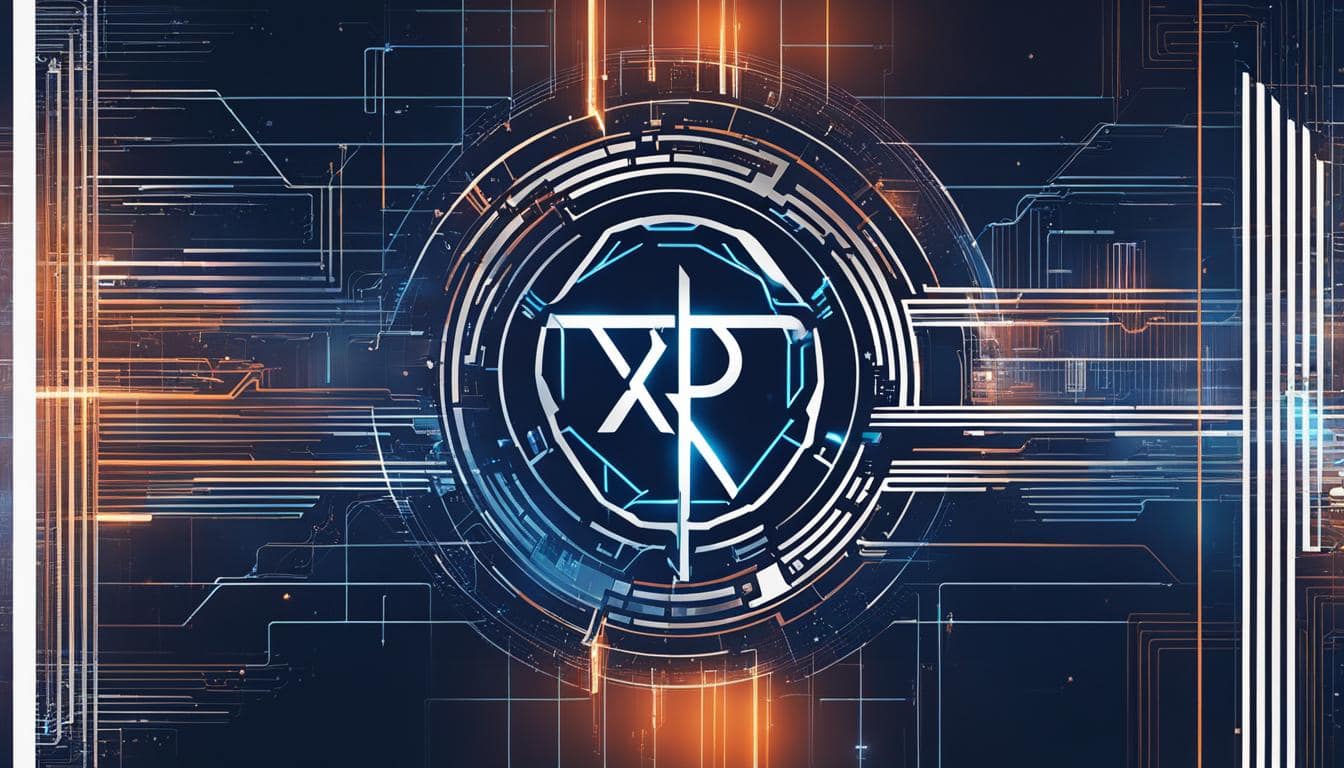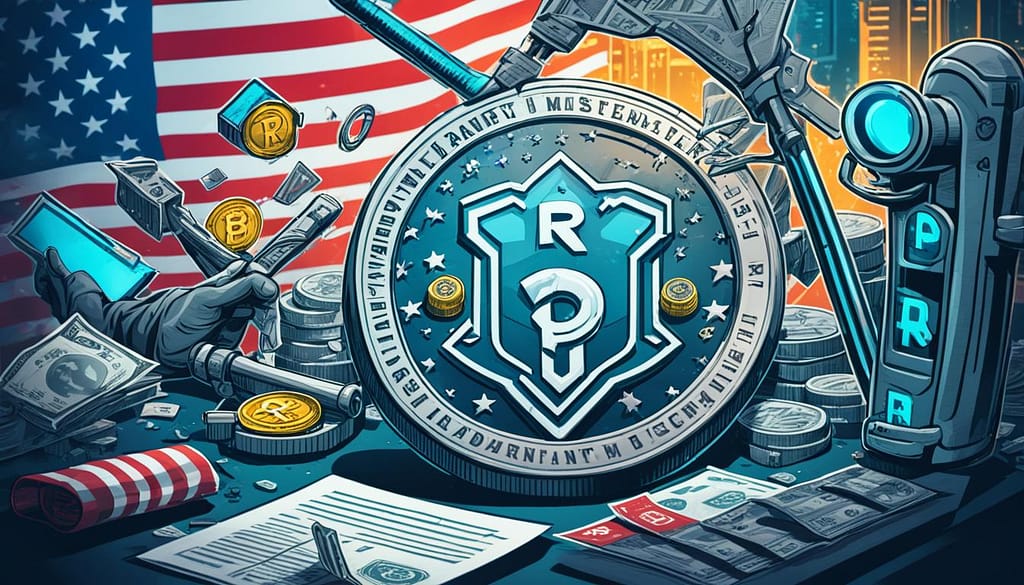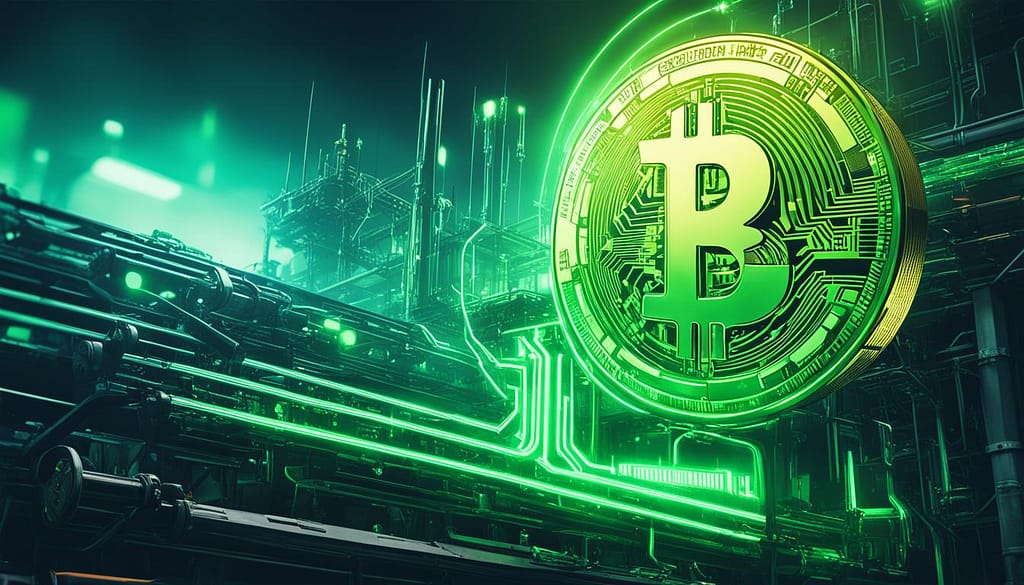What is XRP?
Among the multitude of cryptocurrencies and digital assets populating the innovative landscape of blockchain technology, XRP emerges as a distinctive and potent investment opportunity. This cryptocurrency, cultivated by the financial technology company Ripple, challenges traditional economic paradigms with a swift and energy-efficient approach to monetary transactions. Its conception in 2011 by visionaries Jed McCaleb and Chris Larsen catalyzed the release of a finite batch of 100 billion tokens, a move substantiated by the token’s functionality and cost-effectiveness which has placed XRP at the forefront of digital finance discussions worldwide.
Despite its proven utility as a medium of exchange and its growing adoption, XRP often finds itself at the crossroads of intense debates and legal scrutiny. The discourse largely pivots around the asset’s classification, with regulatory bodies such as the U.S. Securities and Exchange Commission (SEC) challenging its status. Yet, for investors and enthusiasts in the cryptocurrency community, the allure of XRP as an avant-garde financial tool remains undiminished.
Key Takeaways
- XRP serves as a pivotal cryptocurrency within Ripple’s extensive blockchain realm.
- Unmatched in cost-effectiveness, XRP accelerates transaction speeds and reduces energy consumption compared to traditional cryptocurrencies like Bitcoin.
- The total supply cap of 100 billion tokens underpins XRP’s value proposition as an investment opportunity.
- Distinguished by its attributes, XRP attracts global attention, stirring conversations about financial innovation and regulatory considerations.
- Investors continue to observe XRP keenly, eager to delve into its potential amidst an evolving legal and economic environment.
Introduction to XRP: The Digital Asset for Global Payments
Reshaping the way we approach global financial transactions, XRP emerges as a highly-efficient digital asset. Designed specifically for the world’s monetary flows, it streamlines payments across borders, facilitating seamless conversion between various currencies. Its utility in large-scale finance positions it as a staple for those looking to engage with blockchain investments. As a result, XRP has garnered significant attention both as a medium of exchange and as an asset class with appreciable value.
The adoption of XRP by financial institutions globally underscores its potential to alter the payment industry radically. By leveraging the technological prowess of Ripple’s systems, XRP ensures transactions are not only fast but also compliant with the stringent regulatory requirements that govern financial operations. In a market where speed and efficiency are paramount, XRP sets an impressive standard, outpacing traditional methods of money transfer.
Investor interest in XRP is fueled by the asset’s inherent benefits, including its ability to serve as a hedge against market volatility. Amidst fluctuating market conditions, XRP has shown resilience, making it a favored option for blockchain enthusiasts looking to diversify their portfolios. Below, we explore XRP’s unique attributes that substantiate its role as a transformative component in the sphere of digital finance:
- Expedited transfer speed, completing transactions in a matter of seconds.
- Low transactional costs, dramatically reducing overhead for cross-border payments.
- Scalability, capable of handling a large volume of transactions without compromising performance.
- Eco-friendliness, operating with a significantly lower energy requirement than many traditional cryptocurrencies.
As we delve deeper into the intricate web of fintech, XRP’s position remains crystal clear; it’s not just an alternative form of currency but a beacon of innovation in the relentless pursuit of more effective financial solutions. The continuous evolution of its network ensures that XRP remains at the forefront, championing the cause of revolutionized, accessible, and equitable global finance.
Understanding the XRP Ledger and Its Cryptocurrency
The innovative structure of the XRP Ledger is a compelling subject for both veterans and novices in the world of cryptocurrency. Devised as a solution to the perceived inefficiencies of Bitcoin, the XRP Ledger embodies a shift towards a more decentralized and sustainable digital economy. Its underlying protocols and pre-mined nature set it apart, providing a unique framework for transferring value globally.
The Origin and Technology behind the XRP Ledger
Engineers such as Jed McCaleb, David Schwartz, and Arthur Britto envisioned an alternative to Bitcoin’s resource-intensive model. This collective ingenious effort led to the creation of the XRP Ledger—a decentralized blockchain system that operates independently of the company Ripple. The XRP Ledger’s advanced consensus protocol eliminates the need for energy-consuming mining, instead relying on a network of unique node lists that validate transactions and maintain consensus.
Pre-Mined Tokenomics and Total Supply
Unlike the competitive mining process associated with many cryptocurrencies, XRP’s supply was entirely pre-mined, meaning that the total possible quantity of XRP was created at launch. With a ceiling of 100 billion units, XRP’s distribution strategy was methodically planned, including the allocation of a significant reserve placed in escrow. This precautionary measure was meant to regulate the available supply and prevent market oversaturation, ensuring a gradual release into circulation.
| XRP Ledger Feature | Description |
|---|---|
| Total Supply | 100 billion XRP |
| Distribution Method | Pre-mined and set in escrow release |
| Consensus Method | Decentralized consensus protocol without mining |
| Key Innovation | Energy-efficient transaction validation |
| Escrow Mechanism | Stabilizes XRP supply with a schedule for market release |
This proactive approach to tokenomics underpins XRP’s reputation as a digital asset designed for the long-term—an integral factor to consider for those interested in the dynamics of the cryptocurrency market. The decentralized nature of the XRP Ledger coupled with its pre-mined token supply constitute core elements fueling XRP’s ability to reform financial transactions on a global scale.
The Evolution of Ripple and Its Relation to XRP
At the heart of financial technology innovation lies Ripple, a brand that has significantly impacted the fintech landscape through its constant evolution and tight relationship with the digital asset XRP. Now recognized globally for its real-time payment system, Ripple has solidified its role as a leader in the arena of borderless transactions.
Ripple’s Founding and Initial Vision
The journey of Ripple began with Ryan Fugger’s vision in 2004. Fugger, a visionary software developer, conceptualized a decentralized monetary system known as Ripplepay, which enabled individuals and communities to create their own money. This initial breakthrough set the stage for what would become a significant player in the fintech sector. Ripple’s primary ambition has always been to revolutionize the financial industry, imbuing payment transactions with unparalleled speed, security, and transparency while eschewing the limitations found in traditional blockchain frameworks.
From OpenCoin to Ripple: A Brand’s Transformation
In its formative years, Ripple underwent a transformation of minor proportions yet significant impact. It transmuted from Newcoin and further morphed into OpenCoin. This branding pivotal point was foundational, marking Ripple’s commitment to opening up the financial world. Finally, OpenCoin rebranded to Ripple Labs, consolidating Ripple’s identity synonymous with cutting-edge payment solutions and setting the scene for its ultimate inflection into the single, potent moniker of Ripple. The evolution represents a testament to the company’s dedication to innovation and its foresightedness in shaping the future of global payments.
Through each stage of its transformation, Ripple has maintained its original ethos. It’s the driving force behind Ripple Labs’ mission to provide a frictionless experience to send money globally using the power of blockchain technology. XRP, as Ripple’s digital asset, has been an integral part of this narrative, enabling instant liquidity and facilitating cross-border transactions that once took days, now mere seconds.
Ripple’s alignment with fintech evolution is undeniable, as seen through its proactive approach to harnessing and shaping emerging technologies. The synergy between Ripple Labs and XRP goes beyond a mere connection of brand and digital asset; it is emblematic of the transformative power of collaboration between technology and finance. With each milestone achieved, from OpenCoin to Ripple, a unified vision for a more interconnected financial world comes closer to fruition.
| Year | Brand Name | Development Focus |
|---|---|---|
| 2004 | Ripplepay | Decentralized financial network creation |
| 2012 | Newcoin (briefly) | Early stage rebranding, continued development |
| 2012 | OpenCoin | Development of the Ripple payment protocol and currency exchange |
| 2013 | Ripple Labs | Professional branding, financial technology innovation |
| 2015 | Ripple | Implementation of XRP within global payment systems |
Ripple’s metamorphosis from Ripplepay to the powerhouse known today illustrates the indispensable role that fintech innovation has played in modernizing the financial sector. OpenCoin and Ripple Labs are historical bookmarks in the continuing narrative of Ripple’s quest to realize the full potential of what fintech can achieve, propelled by the XRP digital asset.
Defining xrp: More Than Just a Cryptocurrency
When the term XRP surfaces in conversations about digital currency, an intriguing portrait of decentralized financial technology emerges that transcends the customary bounds of virtual currency. As a pivotal constituent of Ripple, a dynamic platform elevating the efficiency of global payment systems, XRP distinguishes itself by providing the infrastructure necessary for swift and straightforward settlements.
Not to be perceived solely as a means of speculative investment, XRP’s role within the innovative paradigm of digital finance is multifaceted. It serves not only as a medium of exchange on various cryptocurrency exchanges but also plays an essential part in the actual mechanics of cross-border transactions.
Central to XRP’s allure as a financial instrument is its deflationary mechanism, a delicate process where each transaction incurs a negligible burn rate of the currency itself. This subtle yet profound feature optimizes currency stability and projects an immeasurably gradual approach to reducing supply, rendering the notion of XRP’s depletion over millennia an academic point rather than a practical concern.
The chart below captures the unique attributes of XRP compared to traditional virtual currencies, highlighting why XRP is much more than a mere cryptocurrency:
| Feature | XRP | Traditional Cryptocurrency |
|---|---|---|
| Transaction Speed | Seconds | Minutes to hours |
| Energy Consumption | Minimal | Often high (depending on the cryptocurrency) |
| Supply Management | Deflationary burn per transaction | Varies (inflationary, deflationary, or fixed supply) |
| Use Case | Interbank/settlement layer | Mostly speculative investment or store of value |
Undeniably, XRP’s existence goes beyond the traditional digital asset mold; it fundamentally redefines the fabric of decentralized financial technology. By enabling real-world utility within an expanding digital ecosystem, XRP claims its stake not just as a virtual currency, but as a robust and forward-thinking financial technology.
How XRP Transforms International Financial Transactions
Embracing a new era of digitization, XRP has significantly altered the landscape of international financial transactions. This digital asset has introduced a convenient, swift, and eco-friendly paradigm that is quickly gaining traction in the global financial industry. Its technology ensures that businesses and individuals can conduct cross-border transactions with unprecedented ease.
Cost-Effectiveness of Using XRP for Payments
Financial transactions have traditionally been expensive due to bank fees, currency exchange rates, and processing costs. XRP stands out as a cost-effective solution that minimizes these expenses. By leveraging its unique infrastructure, XRP slashes transaction costs, offering a pragmatic solution for entities aiming to maximize their economic efficiency. This fiscal prudence is a vital attribute that positions XRP as an attractive option for individuals and institutions alike.
Transaction Speed and Energy Consumption Comparison
Transaction speed is essential in the fast-paced digital economy, and XRP shines by facilitating transactions at a fraction of the time required by traditional financial systems. With its rapid processing rate, XRP transactions are typically settled within 4 seconds, a sharp contrast to the prolonged durations associated with other cryptocurrencies like Bitcoin and Ethereum.
Beyond speed, energy consumption is a considerable concern in the realm of cryptocurrency. XRP is engineered to be a greener alternative, requiring significantly less electricity to operate compared to traditional proof-of-work blockchain systems. This sustainable approach is not only environmentally responsible but also resonates with a growing global demand for eco-friendly financial practices.
As financial institutions and consumers alike strive for more efficient and sustainable economic practices, XRP’s low cost, expedited transaction speed, and reduced energy footprint underpin its burgeoning influence. These factors collectively herald a pioneering shift in how we perceive and engage with international financial transactions. XRP is not just setting a new standard; it’s redefining the global payments ecosystem.
The Legal Landscape: XRP’s Encounters with Regulation
In the rapidly evolving world of digital currencies, the legal landscape has become increasingly complex. XRP, as a leading cryptocurrency, has been no stranger to regulatory scrutiny. Two of the most significant encounters have involved the Financial Crimes Enforcement Network (FinCEN) and the U.S. Securities and Exchange Commission (SEC). These engagements have had far-reaching implications for XRP and the broader realm of blockchain-based assets.
Complications with FinCEN and Anti-Money Laundering Compliance
Amidst rising concerns over illicit financial activities, XRP has found itself under the microscope for potential anti-money laundering (AML) compliance issues. The relationship between Ripple and regulatory body FinCEN first made headlines in 2015 when Ripple Labs was accused of violating the Bank Secrecy Act. Adjustments were necessary to align Ripple’s operations with the stringent requirements of FinCEN, focusing on enhancing the transparency and oversight of transactions.
The SEC’s Lawsuit and XRP: A Landmark Case
The year 2023 marked a crucial juncture for XRP with the SEC’s lawsuit that questioned its classification. Was XRP an unregistered security? The lawsuit addressed the complex interplay between regulation and innovation within the cryptocurrency space. The mixed ruling recognized violations of securities law, while also sanctioning the continued sale of XRP on various exchanges, a decision indicative of the intricate balancing act between fostering financial advancement and ensuring rigorous compliance.
XRP’s Market Performance and Price Volatility
The cryptocurrency market, ever-dynamic and speculative, has seen its fair share of ups and downs, and XRP’s journey has been no exception. Offering a profound case study of market performance and price volatility, XRP has both captivated and perplexed investors seeking to navigate the vicissitudes of the cryptocurrency landscape. Tracing its historical trajectory reveals a pattern marked by robust peaks and troughs, underscoring the investment potential and risks inherent in such assets.
Analyzing Historical Price Movements
In its nascent stages, XRP’s price movements were modest, typically oscillating in the fractions of cents. However, bearing witness to the burgeoning interest in digital assets, XRP’s valuation experienced a meteoric rise, most notably in late 2017. The bullish fervor of the market propelled it to an all-time high, with investors and enthusiasts alike eager to partake in the cryptocurrency gold rush. Yet, as the markets cooled, XRP’s price retreated, embodying the price volatility that is characteristic of many cryptocurrencies. This price trajectory serves as a barometer of market sentiment, providing keen insights into the factors propelling and plummeting its value.
The Impact of Market Sentiment on XRP Value
The narrative of XRP’s worth is inexorably linked to market sentiment. As regulatory news, technological developments, and global financial trends surface, they resonate through the cryptocurrency market, precipitating shifts in investment flows and asset valuations. XRP, with its distinctive positioning in the market and looming regulatory considerations, is especially susceptible to sentiment-driven price swings.
| Year | Significant Price Milestone | Notable Market Events |
|---|---|---|
| 2017 | $3.40 | Cryptocurrency bull market peak |
| 2018 | Significant decline from peak | Market correction and increased regulatory scrutiny |
| 2020 | Stabilized price range | Strengthened adoption and integration into payment systems |
| 2023 | Variable price range | Mixed regulatory rulings and sustained investor interest |
For investors, the price volatility of XRP is both an allure and a caution. While promising returns may beckon, the tumultuous movements demand a strategic approach, grounded in thorough analysis and an understanding of cryptocurrency market dynamics. XRP’s story, interwoven with investment potential, continues to unfold within this digital era’s financial narrative.
XRP vs. Bitcoin: Contrasting the Two Titans
In the digital currency arena, XRP and Bitcoin stand as two pivotal cryptocurrencies, each with unique attributes and methodologies. These differences are particularly evident when assessing their underlying technologies and approaches to scaling and energy consumption. While they both represent innovative strides in financial technology, their paths diverge significantly.
Differences in Consensus Mechanisms
Bitcoin’s proof-of-work (PoW) consensus mechanism is well-known for its security; however, it demands substantial computational power, resulting in higher energy consumption. Contrastingly, XRP employs a consensus protocol that relies on a set of trusted validators and a Unique Node List (UNL). This translates to a significantly reduced energy footprint, as the intensive PoW algorithm is unnecessary to achieve network agreement in XRP’s architecture.
Scalability and Energy Efficiency: XRP’s Technological Edge
The quest for scalability is crucial as cryptocurrencies vie for mainstream adoption. Here, XRP excels with its consensus mechanism, which allows for rapid transaction processing and scalability. In comparison, Bitcoin’s PoW model faces challenges with scalability, often resulting in higher transaction fees and slower confirmation times during peak usage.
Energy efficiency remains a critical concern in the era of environmental consciousness. XRP stands out for its modest energy requirements, distancing itself from the energy-intensive processes associated with Bitcoin mining. Such efficiency is not only crucial for reducing the carbon footprint but also for ensuring that the digital asset is sustainable and favorable in the long-term landscape.
XRP’s innovative consensus mechanisms and attention to scalability and energy consumption present it as a more eco-friendly and future-ready currency than Bitcoin. This comparative analysis highlights the technological advancements that could ultimately influence the adoption and utility of each digital asset within the financial ecosystem.
Securing Transactions on the XRP Ledger
The XRP Ledger stands as a beacon of security in the digital currency world, thanks to its innovative consensus protocol. This protocol is essential in securing transactions by utilizing a network of validators to confirm transactions without the need for energy-intensive mining competition found in other cryptocurrencies. Ensuring that every transaction is synchronized across the network, the XRP Ledger’s validation process is not only environmentally friendly but also provides a fortress-like security against transaction tampering.
At the heart of this stringent security are the validators, a network of trusted nodes that participate in the consensus process. Every few seconds, these validators come to an agreement on the order and outcome of XRP transactions. This agreement, known as a consensus, serves as the final and irrevocable settlement for transactions, rendering them tamper-resistant and immutable. The validators play a pivotal role in maintaining the integrity of the XRP Ledger, providing peace of mind for users and investors alike.
- Robust transaction validation by synchronizing ledger updates among validators
- Consensus reached without competitive mining, reducing environmental impact
- Immutable transactions provide complete security assurances
- Ecosystem of trusted validators enforcing the consensus protocol
The efficiency and security provided by the XRP Ledger’s consensus process are parallel to none, setting the gold standard in the realm of securing transactions. As blockchain technology continues to evolve, the XRP Ledger remains at the forefront, offering a model for others to follow in creating a sustainable and secure network for the future of finance.
Investing in XRP: Opportunities and Risks
When venturing into the world of cryptocurrency, the prospect of investing in XRP can be both enticing and intimidating. A discerning investor’s strategy should always be informed by a comprehensive market outlook and a personalized assessment of risk tolerance. To facilitate a clear understanding of what an investment in XRP may entail, we delve into essential considerations that prospective investors should not overlook.
Assessing the Investment Landscape for XRP
The landscape of XRP investment is ever-evolving, marked by notable fluctuations and trends that reflect broader economic shifts. To discern the potential for XRP in an investment portfolio, examining historical patterns alongside current market outlooks is crucial. An investor’s decision to allocate funds towards XRP hinges on their confidence in its technological potential and regulatory future.
Financial Advice for Prospective XRP Investors
Financial advisement is key when considering an investment in volatile assets like XRP. Industry experts suggest a proportionate investment that aligns with one’s financial goals and risk tolerance. Diversification remains a cornerstone of sensible investing, mitigating the risks inherent in the cryptocurrency markets.
| Investment Factor | Consideration for XRP |
|---|---|
| Volatility | High potential for rapid price changes |
| Liquidity | Varies based on exchange and market conditions |
| Regulatory Environment | Susceptible to change, may impact value and legality |
| Technological Development | Adoption and updates can drive value |
| Market Sentiment | Influenced by news, trends, and investor behaviour |
Investing in XRP can be alluring, yet it is accompanied by a spectrum of challenges that must be judiciously navigated. An investor’s research, analytical skills, and readiness to adapt to the dynamic nature of cryptocurrency are imperative in the endeavour to seek rewards within a territory abundant with risk.
Buying XRP: A Guide to Acquiring the Digital Asset
When it comes to buying XRP, the process is akin to acquiring stocks via an online brokerage; however, instead of stocks, one purchases a digital currency through a cryptocurrency exchange. Leading platforms such as Binance and Bybit have streamlined this process, providing a user-friendly interface that caters to both the experienced trader and uninitiated newcomer.
For those interested in owning XRP, it is crucial to understand the steps involved in the purchase. Firstly, one must choose an exchange, register and complete any required security verifications, before depositing funds. These funds can be in the form of fiat currency—such as the Canadian dollar, U.S. dollar, or Euros—or another digital currency. After funding your account, you may then proceed to buy XRP based on real-time market prices.
| Exchange | Features | Fiat Currency Support | Security Measures |
|---|---|---|---|
| Binance | Largest volume, advanced features | Multiple, including CAD, USD, EUR | Two-factor authentication, device management |
| Bybit | User-friendly, derivative trading | Selected, including USD, EUR | Secure Asset Fund for Users (SAFU), cold wallets |
| Kraken | High security, range of cryptos | Multiple, including CAD, USD, EUR | Global Settings Lock, PGP email encryption |
Understanding the market terms is essential. For instance, market orders buy at the current market price, while limit orders set a specific price at which you’re willing to buy. It’s also pivotal to be aware of transaction fees, which can vary by platform and transaction type.
Once purchased, it’s advisable to transfer your XRP to a private wallet for enhanced security, although some prefer to keep them on the exchange for ease of access and trading. Whether you’re an investor or using XRP for transactions, acquiring this digital asset is a significant step into the cryptosphere and diversifying your digital assets portfolio.
Conclusion
As we look ahead, XRP stands as a compelling entity within the global financial and blockchain arena. Despite contending with intense scrutiny and an ever-changing landscape, XRP’s robust ecosystem continues to demonstrate resilience and innovation. The future outlook for XRP is intricately linked to its ability to navigate technological developments, its integration into institutional frameworks, and the dynamic regulatory environment that shapes the domain of digital assets.
The Future Outlook for XRP and Its Ecosystem
The growth trajectory of the xrp ecosystem is one characterized by potential and anticipation. In the midst of swift technological progression, XRP’s role is expanding, with the currency asserting its relevance and proving its mettle in finance and beyond. Investors and participants within the XRP community remain keenly watchful of its adoption trends and the maturation of its underlying technologies, with the anticipation that its contributions to blockchain innovation will be both significant and transformative.
Summarizing XRP’s Role in Blockchain and Finance
In summation, XRP’s imprint on the sectors of blockchain and finance has been indelible, transcending mere currency functions to become a cornerstone of next-generation transactional processes. As the digital economy evolves, XRP’s utility as both a means of exchange and a beacon of financial progress is poised to cast a sustained impact. Whether for instantaneous international payments or as a thriving commodity within the investment landscape, XRP assures its position as a pivotal player at the juncture of blockchain and finance.
FAQ
What is XRP?
What distinguishes XRP in the realm of digital assets for global payments?
What is the XRP Ledger?
How was XRP pre-mined, and what does this mean for its total supply?
Who founded Ripple, and what was the initial vision?
How has Ripple’s brand evolved over time?
How does XRP serve as more than just a cryptocurrency?
Why are XRP’s cost-effectiveness and speed crucial for payments?
How do transaction speed and energy consumption of XRP compare to other cryptocurrencies?
What regulatory challenges has XRP faced?
How has XRP’s price volatility affected its market performance?
What are the main differences between XRP and Bitcoin?
How does the XRP Ledger secure transactions?
What should individuals consider before investing in XRP?
How can one buy XRP?
What is the future outlook for XRP and its ecosystem?
Source Links
- https://www.investopedia.com/what-is-xrp-6362550
- https://xrpl.org/what-is-xrp.html
- https://www.forbes.com/advisor/ca/investing/cryptocurrency/what-is-ripple-xrp/










